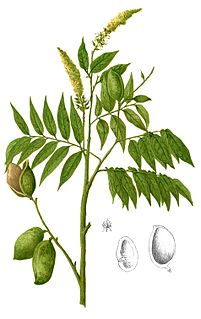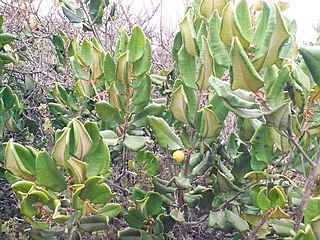
The house crow, also known as the Indian, greynecked, Ceylon or Colombo crow, is a common bird of the crow family that is of Asian origin but now found in many parts of the world, where they arrived assisted by shipping. It is between the jackdaw and the carrion crow in size but is slimmer than either. The forehead, crown, throat and upper breast are a richly glossed black, whilst the neck and breast are a lighter grey-brown in colour. The wings, tail and legs are black. There are regional variations in the thickness of the bill and the depth of colour in areas of the plumage.
Crudia balachandrae is a species of plant in the family Fabaceae. It is endemic to Great Nicobar Island in the Nicobar Islands.

Crudia is a genus of plants in the family Fabaceae.
Crudia bibundina is a species of legume in the family Fabaceae. It is found only in Cameroon. Its natural habitat is subtropical or tropical dry forests. It is threatened by habitat loss.
Crudia brevipes is a species of legume in the family Fabaceae. It is a tree endemic to Peninsular Malaysia. It is threatened by habitat loss.
Crudia lanceolata is a species of plant in the family Fabaceae. It is a tree found in Peninsular Malaysia and Thailand. It is threatened by habitat loss.
Crudia penduliflora is a species of plant in the family Fabaceae. It is a tree endemic to Peninsular Malaysia. It is threatened by habitat loss.
Crudia scortechinii is a species of plant in the family Fabaceae. It is a tree endemic to Peninsular Malaysia. The wood of trees of this genus in called "Babi Kurus" in local language. This plant is threatened by habitat loss due to harvesting of the trees.

Crudia zeylanica, sometimes known as Sri Lanka legume, is a species of plant in the family Fabaceae endemic to Sri Lanka. Once thought to be extinct, the plant was rediscovered in 2019.

The crimson-bellied woodpecker is a species of bird in the family Picidae. It is found in Colombia, Ecuador, Panama, and Peru. Its natural habitats are subtropical or tropical moist lowland forest and subtropical or tropical moist montane forest.

Tachyoryctes is a genus of rodent in the family Spalacidae. It contains the following species:
The Rwanda mole-rat is a species of rodent in the family Spalacidae found in Burundi, the Democratic Republic of the Congo, and Rwanda. Its natural habitats are subtropical or tropical moist montane forests, subtropical or tropical high-altitude grassland, arable land, pastureland, plantations, rural gardens, and heavily degraded former forest.

The northeast African mole-rat is a species of rodent in the family Spalacidae and is found in Ethiopia, Somalia, and northwest Kenya. Its natural habitats are subtropical or tropical moist montane forests, dry savanna, high-altitude shrubland and grassland. It lives a solitary existence underground and produces a small litter of pups twice a year, in the two rainy seasons. Some taxonomic authorities lump this species, along with a number of others in the genus, in which case the English name East African mole-rat is used.
Neolamprologus splendens is a species of cichlid endemic to Lake Tanganyika where it is only known to occur around Cape Zongwe in the Democratic Republic of the Congo. This species can reach a length of 8 centimetres (3.1 in) TL.

Macromia splendens is a species of dragonfly in the family Macromiidae. It is found in France, Portugal, and Spain. Its natural habitats are rivers and water storage areas. It is threatened by habitat loss.
Micropholis splendens is a species of plant in the family Sapotaceae. It is found in Brazil and Venezuela.

Pouteria splendens is a species of plant in the family Sapotaceae. It is endemic to the coastal areas of Central Chile. Due to the current rates of habitat loss, a recent study proposed to reclassify this species as Endangered.

Betta, is a large genus of small, often colorful, freshwater ray-finned fishes, known as "bettas", in the gourami family (Osphronemidae). The best known Betta species is B. splendens, commonly known as the Siamese fighting fish.

Eubleekeria splendens, common names splendid ponyfish and blacktip ponyfish, is a species of ponyfish.

Deppea splendens, the golden fuchsia, is a species of flowering plant in the family Rubiaceae. It has been extinct in the wild since its habitat was cleared for farmland. It grows to 12–15 feet (3.7–4.6 m) tall, appearing as a small tree or large shrub. It was once native to Chiapas, Mexico, but is now found solely in horticulture. It bears gold and pink flowers. Dennis Breedlove, the discoverer, brought back Csapodya splendens seeds in 1981. It is grown in the San Francisco Conservatory of flowers inside the Highland Tropics gallery. The Huntington Gardens in Southern California also has an example growing in its conservatory.










